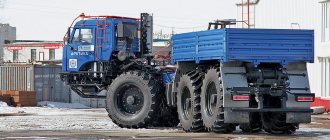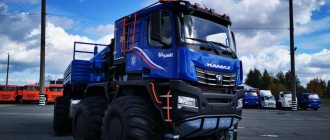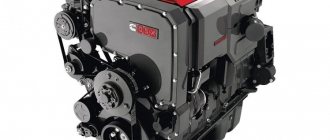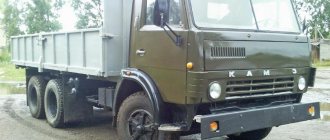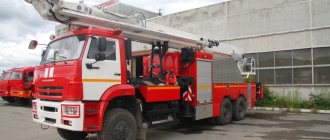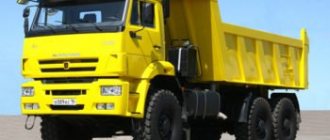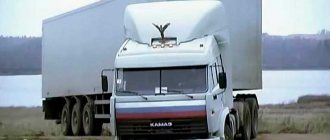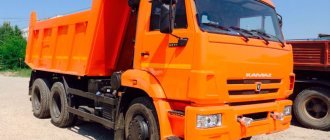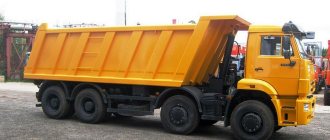The unique KamAZ Arktika all-terrain vehicle is an Arctic special equipment equipped with low-pressure protectors, a vehicle capable of transporting large masses of cargo. The creation date of this technology is 2022. Developers: KamAZ PJSC and the Ministry of Education of the Russian Federation represented by two universities: Moscow Polytechnic Institute and Bauman Moscow State Technical University. This all-terrain vehicle is created in two versions: with 6 X 6 treads and with 8 X 8 treads - KamAZ Arctic 8 x 8.
KamAZ Arctic 6 x 6: technical characteristics
This option is available in two trim levels:
- oversized;
- dimensions
The latter will be able to easily move both on a good road and on a very bad road, where there is practically no road. And there will be no violations of the law regarding dimensions, since the width of this truck is 2540 mm.
The “oversize” configuration is an excellent truck, but it cannot be driven on city roads, since the width of this truck model is 3 m 32 cm. The weight of both models is seventeen tons. Both are capable of carrying weights of up to thirteen tons. In this case, the weight of the equipment will reach thirty tons. According to the technical specifications, KamAZ Arctic has a KamAZ engine with four hundred horsepower. The gearbox is mechanical, sixteen-speed.
KamAZ polar explorer
Polarnik trucks are used to transport goods in the Arctic climate. Such KamAZ models are used in the extraction of coal, oil, and the construction of oil pipelines.
Low pressure tires allow you to move even in off-road conditions. Due to the large diameter of the wheels, the Polarnik is able to ford a river up to 150 cm deep.
The truck is also equipped with a PTO, which allows the use of additional equipment, a winch, and a towing device.
The total weight of KamAZ Polarnik is 30 tons, load capacity is 14 tons. Transport speed – 50 km/h.
KamAZ Arctic 8 x 8: technical specifications
KamAZ Arctic 8 x 8 is an all-terrain vehicle, also created in two trim levels: “oversize” and “oversize”. The ground clearance is the same as that of the KamAZ Arctic 6 x 6. The curb weight of the “oversized” configuration is 25 tons, while the “oversized” version is 24 tons. It is possible to take on board cargo weighing 15 and 16 tons, respectively. The weight of the equipment will be 40 tons. Equipped with a promising in-line KamAZ engine with 450 horsepower. The Alison transmission is a six-speed automatic. Photos of KamAZ Arctic eloquently show the full power of this vehicle.
Prologue to the idea
The development of the Arctic and the Far North has always faced two problems: economic and environmental. Reducing costs in transport and cargo transportation in areas with an underdeveloped road network cannot be solved by aviation alone, since bad weather lasts up to a third of the year. The use of "khivus" - hovercraft - is extremely costly and effective in extreme cases. The railway solves part of the problem, but the effect of laying highways is achieved only when fully loaded, which in sparsely populated areas (like on BAM) begins to lose its meaning.
The use of ground wheeled and tracked vehicles is limited by the task of reducing the negative impact on the ground. Therefore, the main objective of the project was to develop an all-terrain vehicle with the ability to travel on public roads without restrictions and solve transport problems in areas with an undeveloped road network.
The problem of import substitution in terms of wheeled propulsion systems and the development of the groundwork for the creation of remote-controlled, robotic vehicles must be latently solved.
At this stage it became clear that it was difficult to offer one solution for a wide range of problems. Among the standard solutions that the designer chooses in such cases is the search for a single base chassis. Thus, two modifications were identified with an articulated frame and wheel formulas 6x6 and 8x8. Next, it was necessary to clarify the nuances of the design: articulation units, transmission layout, determination of standard sizes of low-pressure tires.
Structural components
The design of this technique is articulated. Consists of the following elements:
- breakable type frame (with its help, rotation is carried out);
- autonomous generator (thanks to which the machine can be operated at low temperatures down to -60 degrees Celsius);
- wheels (can be of two types: for a traditional road surface and for weak soils, swamps);
- driver's cabin;
- module for housing (consists of a bathroom, kitchenette, and a place to relax);
- hanging mechanism;
- articulation unit;
- transfer case.
The suspension mechanism, according to the technical specifications of KamAZ Arctic, has a front suspension (spring). The transfer case serves as a torque distributor between two axles of the vehicle.
Design
The articulated design of the unit includes the following elements:
- Autonomous generator. The equipment can be operated in low temperature conditions (down to -60°C).
- Breakable type frame. Thanks to this new development, this all-terrain vehicle model turns.
- Driver's cabin.
- Wheels. It is allowed to use two types of tires: for standard road surfaces and for driving on soft soils, such as small swamps.
- Residential module. It is equipped with a bathroom, a place for cooking and a place for the driver to rest. All drawers and shelves are built-in and compact.
- Articulation node. It consists of two box-shaped sheet-type structures, which are connected to each other using two hinges. Rotation around the axis occurs thanks to hydraulic cylinders. The folding angle cannot exceed 45°.
- Hanging mechanism. A spring-type front suspension is installed here. The prototype was the parts of the rear suspension mechanism of the KamAZ-5460 unit, and the shock absorbers and stabilizer were borrowed from model 65225.
- Transfer case. It helps distribute torque between the two axles of the unit.
Protectors
The “dimension” model is equipped with Nortec 710\70 protectors with a radius of 38 inches. The “oversize” model is equipped with Dneproshina protectors, each of which weighs 268 kg.
Features of the articulation unit
As you can see in the video, KamAZ Arctic turns not with the help of wheels, but with the help of bending the frame. The articulation unit consists of two box-shaped structures made of sheets, which are connected by two ball joints. By means of a hydraulic cylinder, rotation around an axis is carried out. Max folding angle is 45 degrees.
Why created
KamAZ-6355 "Arctic" 8x8 is the latest heavy super-all-terrain vehicle. It was developed specifically for use in extreme conditions. The Arctic zone, tundra, forest-tundra and northern taiga, bitter frosts - nothing is scary for this giant. It was created to help Russian scientists and military personnel explore the vast expanses of the Far North, Siberia and the Far East.
KamAZ began creating unique equipment after the Russian government adopted a program for the development of the Arctic region in 2014. The fact is that the development of the Far North is being carried out with the help of trucks born during the Soviet period. But time does not stand still. The Russian auto giant has done a lot of work, the fruits of which have become two types of trucks: KamAZ-6345 and KamAZ-6355. These are completely two different cars. The latter is many times superior to its brother.
Table of technical characteristics of KamAZ Arctic
| Load capacity | 13 t |
| Maximum driving speed | 65 km/h |
| Time required for acceleration | 50 s |
| Greatest climb | 45° |
| Ground clearance distance | 0.65 m |
| Average fuel consumption | 33 l |
| Largest overall turning radius | 12 m |
| Maximum torque | 25000 Nm |
| Clutch control system | Pneumatic hydraulic booster |
| Wheel formula | 6*6 |
| Fuel tank capacity | 350 l |
| Engine power | 400 hp |
| Transmission | 16 steps |
| Body type | Cabover |
| Wheelbase of the unit | 3.98 m |
| injection pump | V-shaped |
| Permissible towbar weight | 10 t |
| Number of cylinders | 8 |
| Engine displacement | 11 l |
| Clutch | Friction, disc, dry |
| Wheel type | Pneumatic |
| Rear wheel track | 2 m |
| Operating temperature | Up to -60°С |
| Liquid heater | Yes |
| Type of fuel used | Diesel |
| Electric engine heating | Yes |
| Power flow distribution proportions | To the front axle - 27.5%, To the rear axle - 72.5% |
| Tires | 710/70 R38 |
| Front track | 2.08 m |
| Options | 10*2.54*4 m |
| Motor model | 740.37-400 |
| Curb weight | 17 t |
| Unit weight | 30 t |
| Year of issue | 2017 |
And we will go to the North
As part of the implementation of a comprehensive project
The machine, which became the fruit of the joint efforts of specialists from KAMAZ PJSC, Moscow Polytechnic University, Scientific and Technical Center "Industrial Design" (formerly SKB-MAMI) and MSTU. N. E. Bauman, is conceived as a vehicle capable of transporting people and cargo in the most severe climatic conditions.
The starting point for the development of this topic was the complex project “Creation of high-tech production of environmentally friendly all-terrain vehicles on low-pressure tires for the development of the Arctic zones of the Russian Federation, Siberia and the Far East in the interests of the extractive industries.” Moreover, there is clearly not enough transport with a large carrying capacity, from 10 tons and above, for the specific conditions of the Arctic. The market mainly offers equipment suitable for use in the middle zone, which is not suitable for extreme climates.
It must be said that today the Russian Arctic provides 11% of our country’s national income and 22% of exports. Note that there is more oil under Russian ice than all OPEC countries combined. The Northern Sea Route is acquiring strategic importance for Russia, increasingly becoming a real alternative to the Suez and Panama Canals. The prospects are even more ambitious. So heavy-duty all-terrain vehicles have room to roam.
Search options for the appearance of the all-terrain vehicle
The ultimate goal of the designers is not just to create an all-terrain vehicle with a high payload, but also one that causes minimal harm to the environment.
The project, which started in 2016, was supported by the Ministry of Education and Science of Russia as part of the implementation of the federal target program “Research and development in priority areas for the development of the scientific and technological complex of Russia for 2014-2020.”
As part of the implementation of the program until 2022, three main goals are pursued:
1. Creation of competitive mass production of a unified model range of all-terrain vehicles to solve transport problems in the Arctic and Far North using advanced developments of KAMAZ PJSC.
2. Development of a family of wheel propellers with low-pressure tires with a carrying capacity of 2.5 to 5 tons and ensuring their serial production.
3. Creation of a unified articulated load-bearing system of a vehicle.
Interested organizations will be able to count that the implementation of the conceived ideas will make it possible in practice to solve transport problems in areas with an underdeveloped road network, reduce the economic costs of transport and freight transportation in these conditions, create an all-terrain vehicle transporter capable of also moving on public roads without restrictions, and reduce the negative the impact of transport on the ground, implement issues of import substitution in terms of wheeled propulsion systems and, finally, provide the groundwork for the creation of remote-controlled robotic transport vehicles.
The final version of the design, approved for execution
It is expected that the implementation of the project will help in the development of lowland tundra in eastern Russia and other territories with a cold climate zone. Thus, a beginner must move equally confidently on public roads and impassable terrain: virgin snow, tundra, swampy terrain, loose sand and other weak-bearing soils without causing damage to vegetation and soil.
We also identified a circle of potential consumers of innovative products from the domestic automobile industry. The focus is primarily on transport companies; oil and gas industries; geological exploration; mining industry; organization of energy and water supply; forest industry; environmental organizations; Agriculture; law enforcement agencies, emergency medical services and, of course, the Ministry of Emergency Situations.
The cabin and living module are equipped with handrails and ladders
In accordance with the technical specifications, the KAMAZ Arctic all-terrain vehicle family should include two models with 6x6 and 8x8 wheel arrangements. It is assumed that SUVs will be used primarily for transporting goods, towing trailers, installing special equipment and engineering installations for national economic purposes. The army path of the machine is also kept in mind. The plans are large-scale. To match our country.
The project manager was the chief designer for innovative products of KAMAZ PJSC Sergey Nazarenko.
Aesthetics and comfort
To ensure that the family of Arctic all-terrain vehicles looked stylish, and also provided the crew with the necessary conditions for highly productive work and comfortable rest, specialists from the Scientific and Technical Center “Industrial Design”, as well as their colleagues from Naberezhnye Chelny, were involved in the work. The result of the work of these teams was the creation of an artistic image of the all-terrain vehicle, the interior of the cabin and the residential module, as well as the production of power and frame elements, parts made of composite materials.
During the search process, various options for the external architecture of all-terrain vehicles were considered. But in the end they decided that the main visual elements would be the modified KAMAZ cab and a separate utility compartment.
The living compartment provides comfortable conditions for the crew to rest
Initially, both the design and components were subject to strict requirements for reliability and energy efficiency under operating conditions in the Arctic North. The designers managed to combine the utilitarian properties of the all-terrain vehicle with a stylish appearance and thoughtful ergonomics that meet all the criteria for an autonomous and comfortable stay.
The main emphasis was placed on refining the design of the residential module, elements of the cabin exterior and front bumper, calculating the ergonomics of the components and elements being developed, and selecting cabin lighting equipment and household equipment. We carefully developed design documentation and a mathematical model for the manufacture of a prototype of an Arctic all-terrain vehicle.
Standard equipment includes a kitchen block and a bathroom
Taking the mass-produced KAMAZ cabin module as a basis, we turned it into a new original image. Here, the role of the first violin in the artistic transformation is undoubtedly played by the spectacular front part (facing panel), the sculptural contours of which, together with the four LED headlights, make the car expressive and memorable. A hatch was built into the roof, the cabin was additionally insulated, equipped with handrails and side ladders, and flashing lights were installed on top. The impressiveness of the entire composition is given by the massive faceted bumper, in which, under the cover of protective grilles, there are a pair of blocks of main headlights installed in two tiers in height. At the bottom, a protective panel stands out with its characteristic shape, preventing damage to the engine parts closest to the road. To get into the cabin, you need to climb five high steps - the price to pay for outstanding driving performance.
The cabin was moved forward as far as possible, freeing up space for the living compartment. The latter was made in the form of a frame covered with fiberglass panels, in which the space between the outer and inner walls is filled with heat-insulating material. The volume of living space and internal equipment provide the opportunity for a long journey for three crew members, and in the event of unforeseen circumstances (breakdown or congestion) or extreme weather conditions (blizzard, snow drifts) - in a comfortable environment, wait for help from outside.
This is what the process of boarding a residential module looks like
The interior space is organized like a railway compartment, only the ergonomic design and furnishings are incomparably better. For relaxation, there are wide and soft sleeping shelves located in two tiers near the front wall. Nearby on both sides there was a folding table and a wardrobe. There is a spacious luggage compartment under the bottom shelf. Near the opposite wall there is another soft seat and a real kitchen unit, which includes a hob, a microwave oven, a sink with a tap, an extractor hood, a refrigerator, drawers for storing a variety of products and kitchen utensils, and a two-hundred-liter water tank. The autonomous heater maintains the desired microclimate in the winter cold at ambient temperatures down to -50°C. In summer heat up to +40°C, air conditioning provides life-giving coolness. An audio installation and a TV mounted on the wall will help you pass the time on the road or in the parking lot. To store various things in the household compartment there are a lot of various drawers and shelves.
Naturally, the standard equipment includes a sanitary unit that combines a toilet and shower. Along with two windows, one of which is embedded in the front door, there are electric lamps that cope with their duties quite effectively. For uninterrupted supply of electricity to all consumers, an autonomous generator is provided. The finishing uses the most modern and easy-to-clean materials (aluminum alloys, plastics). In general, in terms of its consumer qualities, the KAMAZ Arctic residential module is in no way inferior to the sleeping compartments of the legendary North American “long-range” tractors.
After installing the wheels with wide tires, fender flares are mounted
The household compartment can only be accessed from the outside, and then only with the help of a ladder, which, in the stowed position, first folds and then slides under the bottom. This is a design flaw, since in severe frost, moving from the cabin to the living module, frankly speaking, is not very convenient, and its interior quickly cools down when the door is open. To facilitate the process of moving from the cabin to the living compartment without going down to the ground, the crew can use platforms, additional steps, handrails and ladders.
Tire aspect
The most important issue when creating the KAMAZ Arctic family was the choice of propulsors. Having studied domestic and foreign experience, we relied on wheels of the largest possible size in this design. This is dictated by the fact that the main indicator that determines the cross-country ability of an SUV is the pressure of the propeller on the ground, which decreases with increasing wheel size, i.e. diameter and width, therefore, of particular importance when creating a family of machines was the determination of the rational dimensions of the wheel propulsion, i.e. low pressure tires.
The choice of external tire geometry is determined by a number of conditions. The diameter should be as large as possible to ensure the largest area of contact with the supporting surface and ground clearance, while the height of the all-terrain vehicle should fit within the 4 m clearance for driving under bridges and overpasses. At the same time, an increase in the outer diameter of the tire leads to a decrease in the maximum steering angles of the steered wheels, which predetermines the transition to another steering pattern (using an intersection joint). At the same time, it should be taken into account that an increase in the width of the tire, which has a positive effect on the cross-country ability, can lead to an increase in driving resistance.
The element of KAMAZ of the Arctic is transportation of people and cargo, work in the harshest conditions
We tried to select the outer diameter of the tire so that the reduction gear ratio in the chassis transfer case would be sufficient to provide the necessary traction properties without making changes to the transmission (installing additional gearboxes).
Research has shown that the above conditions correspond to tires with an outer diameter of 1500-1800 mm and a width of 650-1100 mm.
The co-executor, MSTU im. N. E. Bauman.
Geometric dimensions of KAMAZ-6345-3101
First of all, they began to study the habitat of the new all-terrain vehicle. The territory of the Arctic zone of Siberia and the Far East is characterized by low bearing capacity of the soil - in particular, a thin layer of fertile soil is easily destroyed, “exposing” permafrost. Heavy vehicles moving across the tundra seriously damage soils, which recover extremely slowly in such natural conditions. Therefore, one of the important goals set before the developers was to reduce the negative impact on the environment.
According to available data, existing tires do not have the elasticity necessary to be gentle on the soil. The developed tires use a rubber compound more suitable for arctic conditions. It is assumed that they will be frost-resistant, will be able to remain elastic and cause less harm to the environment.
Since the wheeled propulsion systems of an all-terrain vehicle are subject to very contradictory requirements: minimal pressure on the underlying surface, high cross-country ability and the ability to move the all-terrain vehicle on public roads (respectively, compliance with dimensional requirements), the decision was made and put into practice to create two types of wheels with the conventional names “ Dimension" and "Oversized". The propellers of both options consist of two main elements - a wheel and a pneumatic tire.
The articulation unit is made very rationally
The “Gabarit” option provides not only minimal pressure on the underlying surface, but also the possibility of normal movement on public roads. However, the carrying capacity of the all-terrain vehicle is limited. The geometric dimensions of the vehicle are regulated, since the external width dimensions should not exceed 2550 mm. So it turned out that there was a strictly defined space left for placing the tires. In this case, it is necessary that the supporting surface of the movers be as large as possible. The Gabarit tires, developed at the Moscow Polytechnic Institute, optimally fill the space allocated to them.
Their outer diameter was 1960 mm and their width was 716 mm. The maximum load on the tire reaches 5.3 tons, the internal air pressure is no more than 160 kPa (1.63 kgf/cm2). With these indicators, a maximum speed of 60 km/h and a ground pressure of 140 kPa (1.43 kgf/cm2) are ensured. The weight of the assembled wheel is 526 kg.
The second version of the “Oversized” type wheel propeller has a slightly smaller outer diameter of the wide-profile tire - 1650 mm, but the width is increased to 1050 mm. Thanks to the specific pressure reduced to 113 kPa (1.15 kgf/cm2), better maneuverability on a deformable supporting surface is ensured, but there are dimensional restrictions when driving on public roads. The speed is limited to 50 km/h. By the way, the oversized tire weighs only 388 kg. After installing the all-terrain wheels, fender flares are mounted on the vehicle to protect it from dirt.
All-terrain vehicle front leaf spring suspension
Good traction with the soil in both models is achieved due to a well-developed tread pattern in the form of an oblique, undivided Christmas tree. With “Gabarit” type tires, ground clearance reaches 650 mm, and with “Oversized” tires - 600 mm.
The stage associated with the creation of a family of wheel propulsors for KAMAZ Arctic all-terrain vehicles was completed in June last year. According to the designers, high cross-country ability and environmental friendliness are achieved thanks to low tire pressure and their increased elasticity. An all-terrain vehicle with such propulsors adapts well to uneven surfaces, has an increased ride smoothness, and thanks to the low specific pressure, a reduction in rut depth and overall energy losses during movement are ensured. It is assumed that all operational properties of the propulsion systems will be maintained even in the Arctic zone.
While mass production of new tires has not been mastered, we tried to find out what the industry can offer for this type of vehicle. It turned out that in Russia and the CIS countries tires of this size are mass-produced and installed on agricultural machinery. The domestic radial tire Nortec TA-01 710/70 R38 (outer diameter - 1920 mm, profile width - 710 mm), designed for mounting on the drive wheels of agricultural tractors, has the closest characteristics within the “Gabarit” framework. The tread pattern consists of deep lugs located at an acute angle from the center of the tire to its “shoulder”. Rounded lugs in the “shoulder” area and the presence of a large contact patch when in contact with the soil guarantee high traction. For production, a rubber mixture of a special composition is used, which absorbs shock. Demonstrating reliable adhesion, the product causes minimal damage to the soil without injuring the shoots. The tire load is 5.3 tons, the speed is 65 km/h. This is exactly what the all-terrain vehicle needs.
For the “Oversized” version, the best suited model was 66x43.00R25 SB-1, produced by. Its outer diameter is 1650 mm, profile width is 1052 mm, and the permissible speed is 50 km/h. Previously, the tire was used on heavy tractors Kirovets K-700, K-701, etc.
Rear balancer suspension
True, serial tires have one drawback - they are not suitable for operation at very low temperatures. However, to test the driving performance of an experimental car, such a temporary situation is quite acceptable.
After installing wheels with wide tires, fender flares are mounted on the all-terrain vehicle to protect the cabin from dirt.
driving forces
Within a single family, for maximum unification and cost optimization, three- and four-axle all-terrain vehicles are based on components and assemblies of serial KAMAZ vehicles, which are properly supplemented with original systems and devices capable of providing ultra-high cross-country ability. The first “swallow” to acquire its metallic flesh was a model with a 6x6 wheel arrangement, which was assigned the index KAMAZ-6345-3101. 3D modeling and finite element method were used extensively during the design.
So that a land “dreadnought” over 11 m long could confidently maneuver on a hard road and terrain, the supporting spar frame was made of two parts, which were connected to each other by a device that ensures their mutual rotation in the horizontal plane. The folding angle is ±45°. The articulation unit itself is made in the form of two sheet box-shaped structures connected to each other by a pair of ball joints. Mutual rotation of the sections around a vertical axis is performed by power hydraulic cylinders located inside the frame. This trick made it possible to rationally use the space inside the rear frame of the articulation unit, reduce its overall dimensions, eliminate the loading of the rear frame by forces from hydraulic cylinders, and also protect their rods from dirt and mechanical damage, use a standard frame cross member as a back stop, unify the attachment points of hydraulic cylinders for three- and four-axis models. The “folding” frame made it possible to ensure a minimum turning radius of the triaxle on the outer front wheel - no more than 12 or 14 m, depending on the installed tires. For its larger brother, this figure is 16 m.
Dynamic tests of the KAMAZ-6345-3101 load-bearing system
The energy needs of a three-axle monster with a carrying capacity of 13 tons (with a total weight of 30 tons) are provided by the serial diesel engine KAMAZ-40.37-400 (V8, 11.76) with a power of 400 hp, which is paired with
diaphragm single-plate clutch MFZ 430 with remote pneumohydraulic drive and mechanical 16-speed gearbox ZF 16 S 1822. On an even more powerful 8x8 all-terrain vehicle with a payload of 15-16 tons (depending on the tires used) and a total weight of 40 tons, they plan to install a promising in-line “six” KAMAZ-910.12 with a power of 450 hp, which transmits torque to a 6-speed electronically controlled “automatic” Allison 4500. It is assumed that the service life of the mentioned engine, the production of which is being established with the technical support of the German company Liebherr, will be 1 .5 million km. The force on continuous drive axles with wheel reduction gears, borrowed from KAMAZ-6520, is distributed by a two-stage (with reduction gear) transfer case KAMAZ-633-1800020, equipped with a locking center differential. The unit control is pneumatic. 27.5% of the engine power is supplied to the front wheels, 72.5% to the rear wheels.
Dimensions of the four-axle model
The front drive axle is connected to the frame using springs from the rear suspension of KAMAZ-5460, while shock absorbers, anti-roll bar with struts, buffers, etc. are used from KAMAZ-65225. The rear suspension consists of a pair of rigid balancers that are supported on the drive axles by means of four elastic supports. The correct kinematics of the guide vane is ensured by reaction rods, Panhard rods and anti-roll bars. Ground clearance exceeds 670 mm and the front approach angle is 27°. With such geometry, you can confidently storm the endless snowy terrain. The brake system is of mass production. On board there are two fuel tanks with a capacity of 350 liters each.
A loading platform with folding sides is mounted on the rear semi-frame, the internal length of which is almost 5 m. It is curious that the loading height is 2.2 m. Under the body in the rear of the frame there is a place for a cable winch, which in extreme conditions will help the all-terrain vehicle itself get out of captivity off-road or will provide the same service to other stuck equipment. It is clear that any other add-ons or technological equipment can be mounted in the cargo compartment.
"KAMAZ Arctic" with "Gabarit" type tires (top) and "Oversized" tires
KAMAZ-6345-3101, built this winter, went through a full cycle of laboratory tests, after which it was sent to Yakutia for real testing in harsh northern conditions. It is quite natural that upon completion of testing, the necessary changes will be made to the design of the all-terrain vehicle in order to prepare the already modified vehicle for serial production. In parallel, work is underway on a four-axle model, the length of which exceeds 12 m. The increased useful volume of the front and rear sections allows for the placement of a correspondingly larger residential module (plus additional equipment) and the installation of heavier and larger special equipment or superstructures.
Share
Section articulation
The articulation unit for all machine variants is unified and consists of two sheet-like box structures connected by two ball joints, which provide horizontal flexibility of the front and rear sections to a maximum folding angle of 45°.
Placing two steering cylinders inside the frame made it possible to use the space inside the rear frame of the articulation unit, reduce its size and use a standard frame cross member as a rear support. Thus, the rear frame is not loaded with forces from the GC 100.56x450 hydraulic cylinders, and the rods are protected from dirt and mechanical damage by the frame.
Here the articulation solution itself seems somewhat paradoxical - it does not have lateral flexibility, like in articulated dump trucks (ADT). However, in mechanical engineering there are designs with additional vertical flexibility, but given the extreme conditions, such a complication can only be harmful in future operation. The principle works here: the simpler the better, since the machine is not planned to be used on difficult terrain (that’s why ADTs, as a rule, have two degrees of freedom).
Dimension-oversized
The controversial problem of cross-country ability in the tundra, including wetlands or on snow (crust, firn, snow) is solved by a standard set of tire selection, which determine the size.
For the “Gabarit” option, due to the lack of a domestic analogue, the NORTEC TA-01 710/70 R38 tire was used. In this case, the width of the car is 2.5 m, which allows it to be used on public roads without additional permits. It was in this form that the car was presented at Vuzpromexpo.
For the “Oversized” option, we used the “Dneproshina” ECOWORK SB-1 tubeless tire of size 66x43.00R25 (size 1000/50 R25). The tire of this series is widely used in agriculture on soft soils, water meadows and wetlands. For now, its frost resistance characteristics remain outside the brackets. But the main thing is that the concept is clear, and all that is required is to determine the specifications and properties of the rubber.
The original "walker"
As the experience of creating wheeled all-terrain vehicles Valmet and Foremost for the tundra and the Far North shows (several vehicles were purchased by the USSR in the late 1980s), in “standard” operating conditions one degree of flexibility is quite enough, and the problem of loss of traction due to insufficient rebound and compression of the suspension can be solved using inter-wheel locking. Since rotation is carried out only in the longitudinal plane, non-trivial decisions had to be made in the suspension.
The front suspension of the VTS 6x6 "Gabarit" uses a KAMAZ-6520 rear axle, springs from a KAMAZ-5460 rear suspension, shock absorbers and a stabilizer from a KAMAZ-65225 suspension. That is, the problem of unsprung masses has already been solved by the standard set. The suspension of the rear section does not contain any surprises, except for the fact that the springs are replaced by rigid balancers, which rest on the driving middle and rear axles through elastic supports.
